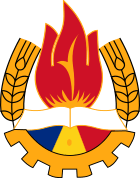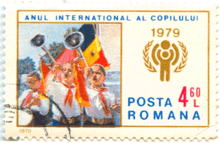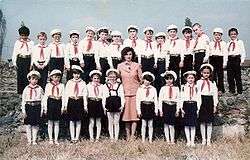Pioneer Organization
The Pioneer Organization (Romanian: Organizaţia Pionierilor) was a pioneer movement in Communist Romania, founded on April 30, 1949.



Most students joined the organization while in the second grade and remained pioneers throughout eighth grade, therefore, in practice, the normal age range extended from seven to fifteen, or nearly fifteen.
Mission
The organisation's responsibilities paralleled those of the Union of Communist Youth (UTC) and involved political (preparing children to become party members) and propagandistic training. Until 1966 the Pioneers functioned as an integral part of the UTC, but thereafter it was under the direct control of the Central Committee of the Romanian Communist Party. 70 percent of the 9-14 age group, or approximately 1.3 million young people, belonged to the Pioneers in 1981.[1] The organization published Cutezătorii.[2]
The Pioneers ran a variety of summer camps and other activities, also having a number of recreation centres around Romania. For instance, Cotroceni Palace became the Pioneers' Palace on June 1, 1950.
The Pioneers served an important propaganda function, as a central part of their activity lay in mass demonstrations, held on August 23, May 1, November 7, and, starting in the 1950s, on the birthdays of Vladimir Lenin and Joseph Stalin, as well as Youth Day. In later years, three to five thousand Pioneers would be brought to Bucharest (7,000 in 1987), training rigorously every day for a month (two hours in the morning and two in the evening) before their moment in the spotlight.
Uniform
Members wore a small triangular red scarf (with the triangle over their backs), with a red-gold-blue strip outside border (red-gold-blue were, and still are, the colours of the Romanian national flag). Both ends of the scarf were passed through a narrow ring of clear plastic. They also had pioneer uniforms that they wore on certain days instead of their regular school uniforms. When in school uniform, students had to wear their pioneer scarves.[2]
Individual awards could be bestowed on members; these included stripes, along with the titles "Pionier de frunte" ("Leading Pioneer"), "Cutezătorul" ("The Brave One"), "Pionier fruntaş în muncă patriotică" ("Leading Pioneer in Patriotic Work") and "Meritul pionieresc" ("Pioneer Merit"), as well as insignia based on the type of activity. Collective awards came in the form of diploma-like scrolls: "Unitate fruntaşă" ("Leading Unit"), "Detaşament fruntaş" ("Leading Detachment") and "Grupă fruntaşă" ("Leading Group"). These were commonly awarded at the school's annual year-end ceremony.
See also
References
- Notes to National Minorities in Romania Archived 2016-03-03 at the Wayback Machine, Elemér Illyés, 1982.
- "DDR & Ostalgie - Lexikon - Pionierorganisation der SR Rumänien". Archived from the original on 2008-04-26. Retrieved 2008-04-25.